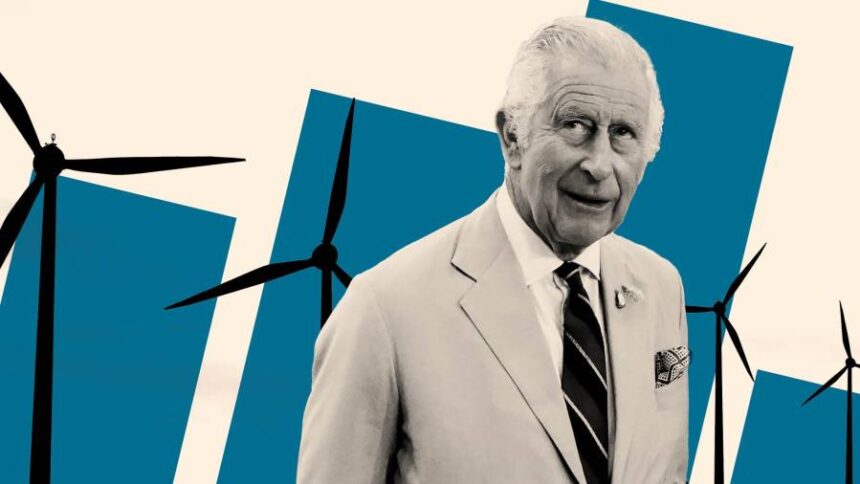Receive free The Royal Family updates
We’ll send you a myFT Daily Digest email rounding up the latest The Royal Family news every morning.
Long before Charles III became King, people close to him were trailing the prospect of a “slimmed-down, modernised” British monarchy once he acceded to the throne.
So it was something of an about-turn when the Treasury announced last month that, far from cutting the royal cloth to match the times, the monarchy would instead be getting a pay rise of about 45 per cent.
The increase in public funding — from £86.3mn this year and next to £124.8mn in 2025-26 and £126mn in 2026-27 — is driven by one of the more contentious sources of royal income.
The Crown Estate, which controls the monarchy’s legacy portfolio of assets, is set to earn more than £8bn up to 2031 from a boom in revenues from offshore wind projects. This is because the monarchy owns the seabed up to 12 nautical miles from Britain’s coast.
The royal household receives a percentage of the estate’s profits in an annual payment known as the sovereign grant.
In January the King said that the monarchy would do without its share in the renewable energy bonanza for “the wider public good”, in what was widely seen as a smart move, heading off potential controversy at the start of his reign.
Accordingly, trustees of the sovereign grant — prime minister Rishi Sunak, chancellor Jeremy Hunt and treasurer to the King Sir Michael Stevens — revised down the percentage of Crown Estate profits accruing to the monarchy from 25 to 12 per cent.
But even after this, the King’s household income will shoot up in cash terms because of the overall increase in Crown Estate profits, the Treasury forecasts.

The Royal finances have long been the subject of political wrangling.
In 1760 George III surrendered hereditary revenues from the Crown Estate in return for a fixed annual payment. Between then and 2012, the monarchy was financed by a discretionary amount set by government and approved by MPs.
In 2012 then-prime minister David Cameron changed the formula so that public funding of the royal household came instead from 15 per cent of the profits of the Crown Estate, all of which previously accrued to the Treasury.
The government also guaranteed that the grant would never be lower than the year before, by agreeing to make up the difference if the estate’s profits fell.
In 2017 the percentage in the formula was revised up to 25 per cent by then-chancellor George Osborne to finance the renovation of Buckingham Palace.
Since then the Crown Estate has begun to reap the dividends of a boom in renewable energy thanks to unprecedented interest in the auction of seabed licences for wind farms.
As a result the corporation’s profits are forecast to rise from £442.6mn this year to £1.04bn in 2023-4, according to the Treasury.
Funding for the monarchy would have been much higher if the government had stuck to the previous 25 per cent formula. But despite the reduction in the percentage of profits it will receive, the cash payout is still on an upward trajectory.

Among republicans — around one in four Britons according to recent polling — this news has triggered a furious reaction.
“In 2025, the King will receive an eye-watering 45 per cent rise. This is at a time when nurses are receiving 5 per cent and other key public workers are still fighting for a fair wage,” the campaign group Labour for a Republic wrote in a letter to opposition Labour leader Sir Keir Starmer.
“We believe that this award is morally unjustifiable,” it said, urging Starmer to revisit the way the monarchy is financed and restore oversight by parliament, should he become prime minister after the general election next year.
Some commentators believe the increase is incompatible with the public mood.
“He was going to be a modernising monarch and cut back on extravagance . . . There is no sign of anything like that happening,” said royal historian and writer Clive Irving, who argued that the long-term fate of the monarchy depends on it becoming publicly accountable, like any other state institution.
Buckingham Palace declined to comment. The Treasury said the sovereign grant had been largely unchanged since 2020, and the projected increases would “provide the remainder of the amount agreed in 2016 for Buckingham Palace reservicing”.
Once the palace’s refurbishment is complete, the government will set the grant “to an appropriate lower level”, the Treasury said.
The Royal family have other sources of income too. The King’s income from the Royal Collection Trust, which manages one of the largest art collections in the world, is set to rise from £10mn this year to nearly £16mn in coming years, according to the Treasury.

The king and his heir Prince William receive private income from the estates of the Duchies of Lancaster and Cornwall. The Duchy of Lancaster recently announced a 9.6 per cent increase in annual profits, from £24mn to £26.3mn. The Duchy of Cornwall made a record surplus of £24mn.
Support for the monarchy fell to its lowest level ever in April, with only 29 per cent of those surveyed saying they thought it was “very important”, according to the National Centre for Social Research. A separate poll for the Daily Mail in May found 73 per cent of those surveyed thought Charles must modernise the monarchy if it is to survive.
“They are more vulnerable on finances than anything else at a time when families are struggling to put food on the table,” said Norman Baker, a former Liberal Democrat minister and author of a book examining the royal finances.
Baker has long argued the UK should trim its royalty to a size more like its European counterparts. For example the Swedish royal family received £11.5mn in public funding in 2021.
He and other advocates of reform doubt that change will come soon. Neither of Britain’s main political parties appear willing to rock the boat before elections next year.
But the demand for change is growing. “It’s a door that can be pushed on,” said Labour MP Clive Lewis.
The second chart in this story has been amended after publication to clarify the scale of the public funding involved








